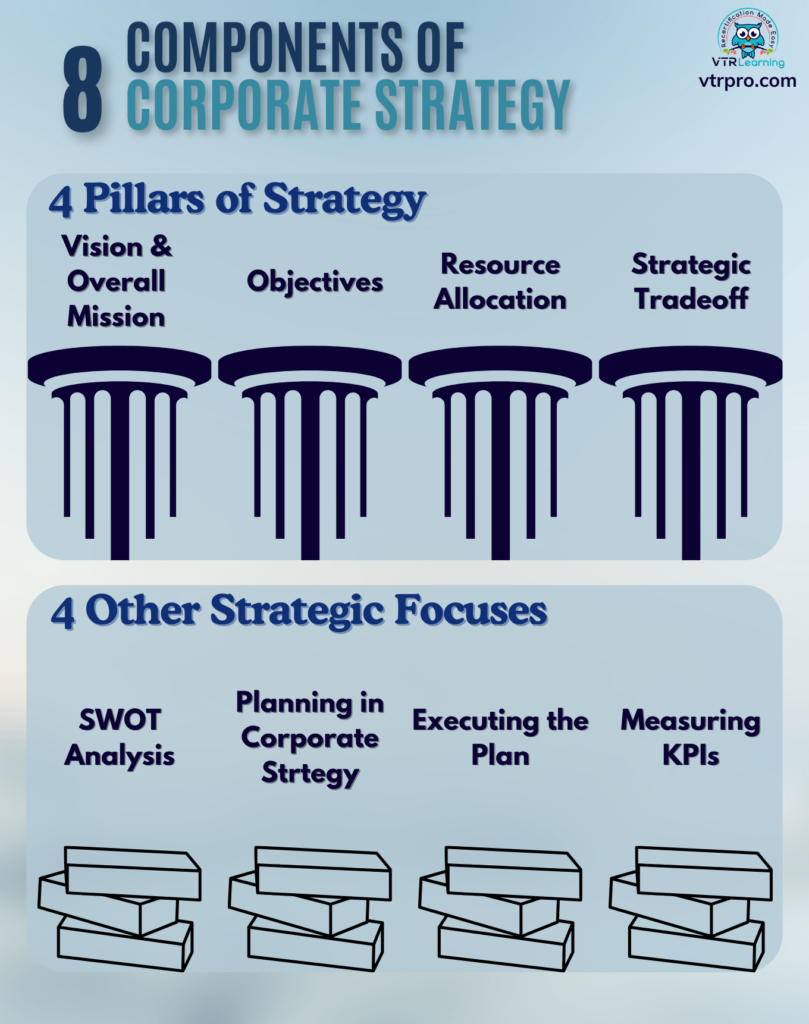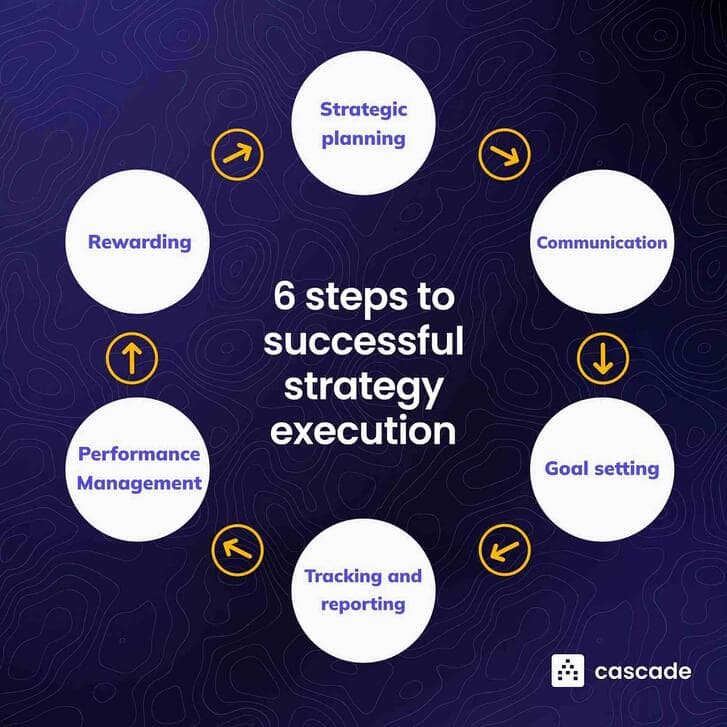
When it comes to corporate strategy, most business owners know they should be thinking about it. But unfortunately, not many know how to do it very well, which might be why nearly 90% of startups fail. After all, strategy isn’t only for mega corporations or huge conglomerates. It’s a vital aspect of business, from the smallest to the largest. So, if you’re not sure of your corporate strategy, you’ll want to invest in it as quickly as possible.
Fortunately, there are eight key areas of corporate strategy which can help simplify it all for those who aren’t sure where to begin. So, if you know you need to get started, don’t hesitate any longer. Just start look into these actionable components.

Share this Image On Your Site
The Four Pillars of Corporate Strategy
Vision and Overall Mission
Perhaps the most important part of a business strategy is the vision – the idea of what a company hopes to achieve. And make no mistake, a business might change its mission repeatedly throughout its lifetime. So, the vision at the beginning might look completely different than at midlife and the end. After all, the ability to adapt with time and culture is itself a vital aspect of growth and success. Businesses which fail to adapt often fade away, and knowing how to change is necessary.
However, certain aspects of a corporate mission may never shift. Company values might always stay concrete, and lifetime goals may never waver. But as certain goals are met, it’s important for leadership to continue setting new objectives. A company just starting out may have little idea of what they could achieve in thirty years. But a five-year plan is much more manageable.
Ultimately, the process of defining corporate vision and overall mission will come down to individual businesses. But the importance of these components to corporate strategy should be entirely clear for all. Because if your company lacks clarity on where it’s trying to go, it will never have a way of getting there.
Objectives
Naturally, the different components of corporate strategy work together to form a comprehensive and actionable plan. So, overlap between these different aspects should be expected. But rather than muddying a clear picture of strategy, this overlap should highlight how holistic the process becomes. Moving from vision and mission into objectives might seem synonymous, because the company’s mission is the overall goal. But in terms of strategy, objectives in this sense are more like stepping stones along the path to the larger vision.
Essentially, these objectives are smaller than the overall vision but pave the way for the company to reach its ultimate ends. When setting these types of objectives, it’s paramount to make sure they’re SMART. This means that all goals should be:
- Specific
- Measurable
- Achievable
- Relevant
- Time-bound
Each aspect of a SMART goal plays into a company or team’s ability to accomplish its purpose. Setting specific, achievable goals helps define a plausible and defined objective. Relevance ensures that the goal matters in the context of the larger vision. Time-bound goals have a specific period in which to be met, while measurability means success or failure can be determined.
Stated bluntly, every objective a business sets should be SMART. And similarly to an entity that has no overarching vision, it will be extremely difficult to accomplish anything otherwise.
Resource Allocation
The third vital pillar for corporate strategy is resource allocation, which relates both to people and capital. Of course, this process looks entirely different from one business to another, particularly when they span separate industries. For example, resource allocation for an online course provider like VTR Learning differs greatly from a large-scale vehicle manufacturer. Digital courses take up no physical space, they can be sold again and again without using up natural resources. Vehicles, on the other hand, require physical materials. Each one built reduces the company’s resources, which have to be replenished. So, allocating these resources is an essential part of the strategic process.
However, materials constitute only part of the allocation component, because other resources like time and people also come into the picture. Every company has a limited amount of human resource – that is, employees. So, it’s important for leadership to determine the optimal mix of staff responsibilities as well as accounting for the time each individual spends on certain tasks.
Resource allocation can become an extremely detailed process, especially when it becomes more granular. But for a company to meet it’s overarching objectives, it must know where to spend time, energy, and resources for optimal results.
Strategic Tradeoff
Of the four pillars of corporate strategy, strategic tradeoff might be the most difficult to achieve. Because it often means saying “no” to arguably good ideas and making sacrifices for the best of the company. Essentially, strategic tradeoff refers to the process of selecting very specific paths to success while rejecting others. Unfortunately, this isn’t as easily done as said. After all, company leaders often experience confirmation bias when dealing with plans and ideas close to their hearts. So, being objective when determining the best path forward can be extremely difficult.
However, choosing to sacrifice one area for another is often paramount to business success. Sometimes, growth can’t happen without decreasing profit. Perhaps increases in customer satisfaction means sacrifices in call center efficiency. The examples could go on, and they would change for every business. But perhaps that’s the point of corporate strategy – it will differ for every business. Strategy isn’t a one-size-fits-all solution, and trying to force one company into the mold of another could lead to disaster. So, taking the time to establish these four pillars is essential for businesses of all sizes.
Four Secondary Components of Corporate Strategy
Of course, the four pillars of corporate strategy encapsulate the vital aspects of the process. However, there are other components that also make the enterprise more well-rounded. Some of them might represent methods of carrying out the four primary parts of strategy. Others might be methods for measuring success or for ensuring the strategy stays on track. Regardless, these secondary components help business leaders formulate their strategies in more-depth.
SWOT Analysis
Essentially, a SWOT analysis is a measure of the strengths, weaknesses, opportunities and threats of a company. And as such, they focus both on the internal aspects of the business as well as external factors. Naturally, assessing a company’s strengths and opportunities reflects the positive abilities of that business. Alternatively, negative aspects reflect internal weaknesses and threats to the company from the outside.
Performing a SWOT analysis is an integral part of forming a corporate strategy, because it highlights areas where the company could excel. But at the same time, it warns of potential areas where the business could falter. Understanding both of these areas well is paramount to setting SMART goals and effective overarching strategies. Because if businesses set unattainable goals in areas they’ll struggle to find ground in, they could end up crippling themselves.
Generally, SWOT analyses work best when voices from different parts of a company are allowed to speak. If carried out only from the executive perspective, SWOT could conform to leadership bias. Providing a variety of data points and perspectives might instead uncover areas previously undiscovered or ignored. And after the findings of the analysis are recognized, leaders can begin forming specific strategies around them.
Planning In Corporate Strategy
Those who fail to plan instead plan to fail. Both Winston Churchill and Benjamin Franklin stated similar maxims, and for good reason. When it comes to formulating a corporate strategy, business leaders must recognize specific methods for achieving goals. Of course, SMART goals help with this – they recognize that objectives can be achieved. However, simply setting a goal doesn’t tell anyone how to accomplish it. This is where the planning stage comes in. SWOT analysis leads to planning, planning leads to accomplishing goals, and accomplishing goals helps recognize the corporate mission or vision.
In this order, planning is the bridge between mere data and large-scale success. Attempting to execute a corporate strategy without a plan is nearly impossible, because strategy is, in itself, a type of plan. Strategy represents the way of moving from unrealized potential to major accomplishment. In effect, one cannot happen without the other – planning is essential to carrying out a successful strategy.
However, as most leaders are aware, plans don’t always proceed smoothly. Different constraints might actually keep them from happening on time or at all. For example, some steps for building a house can’t take place if the weather turns bad. Thus, it is essential for those in charge of the planning phase to account for different variables that could set them back. Moreover, they should set up contingencies in case things go awry. That way, if a plan cannot be carried out according to the letter, they have alternative routes for accomplishing the goal regardless.
Executing the Plan
Any plan lacking execution is nothing more than a good idea. Because without concrete methods and actions for carrying out the steps of a plan, it only exists in the mind. Unfortunately, many leaders get caught up in this step. They know how to formulate great methods for achieving their goals. But when it comes to carrying them out, they seem stuck in the mud.
Key execution steps like task assignment, setting clear expectations, regular communication, and performance tracking can aid the process. But accountability for leaders is also a massive stride toward successfully carrying out a plan. Business leaders do well to surround themselves with others – employees or peers – who can help keep plans on track.
When done correctly, strategic planning and execution operate cyclically, leading from one step to the next and feeding back into the initial phase.
Measuring KPIs
Finally, in carrying out the corporate strategy, it’s important to make sure you’re measuring different KPIs to determine success. That way, alterations can be made along the way as needed. KPI stands for “Key Performance Indicator”, and refers to different metrics which determine success or failure. For instance, a customer success representative might track the number of incoming tickets after a website update. A bakery might measure the number of pastries sold after implementing a new recipe. Perhaps a city government tracks the number of arrests after a new law goes into effect. The list goes on and on, and obviously varies by industry.
The main idea is that the success or failure of a strategy isn’t obvious unless key metrics are measured. So, it’s important during the planning phase to determine what aspects the company should track in implementing the new plan. That way, they can set up specific systems of measurement beforehand and prepare to analyze whatever data necessary.
Learn More About Corporate Strategy
Obviously, establishing a worthwhile corporate strategy takes no small amount of effort. There are many different aspects that go into the process – far more than can be adequately noted here. But because it’s such a vital aspect of any organization, leaders have to know how to carry out a strategic plan.
If you’re still unsure how this might look in the context of a real business, VTR Learning can help. We have a host of online business strategy courses that demonstrate how all of the steps tie together. Furthermore, various courses are accredited by NASBA, SHRM, HRCI, and the American Payroll Association. So, if you’re looking to invest in your corporate strategy while earning continuing education credit, check them out.
Last Updated:






